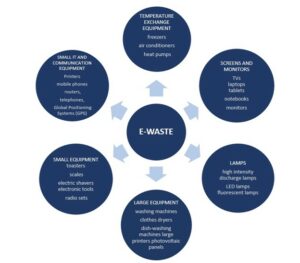E-waste is a colossal problem and grows more complex each day. Every day we dump boatloads of electronic waste into our landfills, polluting our environment, soil, and water sources. Sorting and recycling e-waste is a crucial step towards sustainability.
 E-waste can be found in a wide range of products powered by battery or electricity and according to the directive 2012/19/EU it can be separated into following main categories:
E-waste can be found in a wide range of products powered by battery or electricity and according to the directive 2012/19/EU it can be separated into following main categories:
More analytically, the first category refers to temperature exchange equipment, with other words, cooling and freezing equipment which typically includes freezers, air conditioners, heat pumps etc. The second category refers to screens and monitors, for example, televisions, laptops tablets and monitors. Additionally, the third category refers to lamps since many typical equipment include high intensity discharge lamps, LED lamps and fluorescent lamps.
To continue with, the fourth category associates with large equipment which includes washing machines, clothes dryers, dish-washing machines, large printers, photovoltaic panels etc. On the other hand, the fifth category refers to small equipment such as toasters, scales, electric shavers, electronic tools, radio sets, small monitoring and control instruments, electrical and electronic toys and video cameras. Finally, the sixth category refers to small IT and communication equipment which include mobile phones, routers, telephones, Global Positioning Systems (GPS) and printers.
It can be mentioned that each category has a different lifetime profile thus consequently each category has different waste quantities and potential environmental and health impacts, facts that create the necessity for different waste management and recycling technology.
Understanding these classifications will help users and consumers to categorize their e-waste more consciously, and thus, make their recycling efforts more effective!
✍🏻Publication/graph, prepared by (PP3) RETHYMNO.


